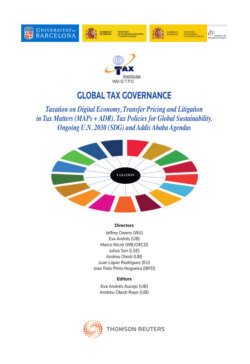Читать книгу Global Tax Governance. Taxation on Digital Economy, Transfer Pricing and Litigation in Tax Matters (MAPs + ADR) Policies for Global Sustainability. Ongoing U.N. 2030 (SDG) and Addis Ababa Agendas - Jeffrey Owens - Страница 9
На сайте Литреса книга снята с продажи.
1. GETTING THE RIGHT BALANCE BETWEEN RISKS AND OPPORTUNITIES OF DIGITALIZATION
ОглавлениеMuch of the current debate has focused on the negative impacts of digitalization such as challenges to traditional tax concepts. For example, the Permanent Establishment (PE) concept which has for a century been the bedrock of tax treaties determining who is allocated the right to tax under tax treaties. Physical presence over a period time (though “permanency” was never actually required) was taken as a good proxy for a significant economic presence which should be subject to taxation of profits made through that presence.
Over the years the PE concept has been adapted to changing business models, though it has its own uncertainties, differing interpretations and issues of practical application. It has at times been abused to avoid taxation where profits are made, and where citizens and governments expect profits to be taxed as a matter of tax fairness.
Digitalization is not the first challenge to the PE concept, but it is the latest challenge and the response has been that for digital companies we need to go beyond physical presence to identify where the “value” is “created”, though there is no clear global consensus on identifying that value, putting a price on it, and identifying where the value is “generated” – especially with increasingly complex global value chains.
Much of these debates have focused on how to treat intangibles since these are today the main drivers of the wealth and profits of companies (it is what you know rather than buildings and plants and payrolls that generate profits).
Linked to this is the broader debate on “source” versus “residence” country taxing rights. With global value changes and new technologies such as 3D-printing it is more difficult to have a clear distinction between source and residence countries. Economists would query what tax lawyers regard as the “source country” for income, and it tends to depend on “deeming provisions” in treaties and laws to give some clarification in an unclear area. The matter is complicated for developing countries, as capital importers, tend to prefer source country taxing rights, while developed countries tend to prefer limiting source country taxing rights, as capital exporters. The challenge is that many of the latter countries see themselves as capital importers of highly digitalized services, and seek strong source country taxing rights, while preferring, including for the benefit of their companies abroad, a more residence country-based taxing model internationally. The additional challenge is the difficulty and questionable nature, of any attempt to ring-fence the digital economy from an increasingly more digitalized economy general.
Digitalization also challenges the Arm’s Length Pricing (ALP) approach in transfer pricing – the potentially manipulated pricing of internal MNE transactions. This approach is based upon the idea that you can allocate the profits of an MNE on the basis of the separate entity concept, that each component is a separate legal entity. Some commentators believe that the ALP can be adapted to today digital environment, (me included) while still retaining the inherent good sense of looking at market pricing; others consider that we need to move to a Global Formulary Approach. This is at the center of Pillar 1 of the BEPS 2.0 digital taxation debate.
These challenges are not limited to the CIT. They also apply to:
o VAT although we seem more successful in adapting our VAT rules than our CIT rules, and implementing a destination approach that recognizes the importance of markets to value creation, and that consumption is a less mobile factor than capital.
o And there are also challenges to the way we tax individuals, particularly the HNWI, who have greater freedom in where to carry out their digital activities. This has led countries to put in place special regimes to attract such people.
o More generally digitalization challenges of what is harmful and what is acceptable tax competition in a digital environment and this will require updating the standards set by the EU code of conduct group and the OECD.
New opportunities
What is missing from the EU debate is a focus on the opportunities opened up by digital technologies –AI, ML, Data Mining, Blockchain and others– to transform (disrupt) the way EU tax administrations operate and interact with each other and non-EU administrations. The EC to its credit has tried to push this agenda but member states have been reluctant (e.g. on harmonized digital platforms for VAT).
These technologies have the potential to reduce the tax gap, to reduce the compliance and administrative costs of taxation, to provide a level playing field between different sectors and between MNES and SMEs in such sectors (recent EU data suggests that 70% of SME are digitalizing and governments need to keep up – as expectations of their digitalization will legitimately increase) and to improve the competitiveness of EU companies in global markets.
Countries like Estonia, Italy and Spain have shown what can be done but more can be achieved by a coordinated approach.
